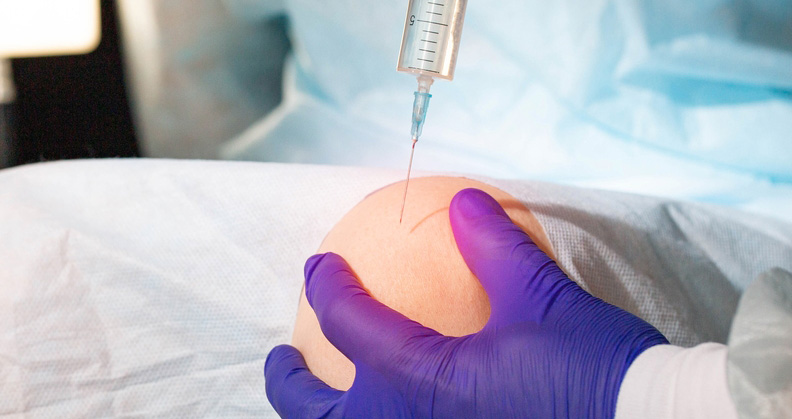
Researchers at Wake Forest Institute for Regenerative Medicine have developed an injectable cell therapy that’s designed to treat osteoarthritis (OA) by overcoming the inflammatory environment in joints while simultaneously regenerating cartilage.
The treatment could bring relief to the 520 million people worldwide who suffer from the debilitating pain and inflammation caused by OA.
Healthy joints have the capacity to recruit and send inflammatory cells to injury sites to help repair damaged tissue. Traumatic injury in OA joints causes inflammation of the synovial membrane and leads to cartilage damage. The inflammation gradually worsens, which degrades the cartilage that lines the bones of the joint and leads to chronic inflammation of surrounding tissue. These developments eventually cause severe pain and swelling in the joint, and can lead to joint replacement.
“Without a better understanding of what drives the initiation and progression of OA, effective treatment has been limited,” said lead researcher Johanna Bolander, Ph.D., an Assistant Professor at the Wake Forest Institute for Regenerative Medicine. “Initially, we studied what goes wrong in osteoarthritic joints, compared these processes to functional environments, and used this information to develop an immunotherapy cell treatment.”
The researchers published their findings in the journal Science Advances.
Investigating the Root Cause
Dr. Bolander said that degenerative diseases such as OA are often caused by failed tissue regeneration, leading to the onset of fibrosis. “One of the most crucial aspects of functional tissue regeneration is the activation of appropriate progenitor cells that are able to regenerate damaged tissue,” she said. “Our goal when we started this project was to develop a treatment that could stop the progression of OA and ideally cure the condition.”
Research findings published in Nature Communication and Developmental Biology show that traumatic injuries in mice lead to the activation of local progenitor cells in the synovial membrane. “About one week after injury, these progenitor cells have migrated to the injury site, potentially through the synovial fluid, where they aid in healing,” Dr. Bolander said. “Based on these findings, we wondered how this is reflected in an OA setting.”
Specifically, Dr. Bolander and her research team wanted to know if progenitor cells that can participate in the healing of OA-associated chondral/osteochondral lesions are present in the local synovial fluid of OA patients and, if they are, what stops them from healing damaged cartilage.
To find out, the researchers investigated the composition of synovial fluid taken from OA patients with a focus on the functionality of the heterogeneous cell population. They investigated the cells’ ability to contribute to the processes crucial for tissue regeneration — migration, attachment, proliferation and chondrogenic differentiation — from a progenitor cell point of view.
“We found that the cells themselves could undergo these processes under standard conditions, but their capabilities were significantly impaired when we added a small amount of autologous synovial fluid,” Dr. Bolander said.
The results did not surprise the researchers, but they did demonstrate the need for a therapy that can overcome and override the pro-inflammatory environment that the OA synovial fluid environment provides.
“OA is a multifactorial disease,” Dr. Bolander said. “Treating only one aspect of it temporarily slows down the vicious cycle. We, therefore, needed to target all aspects of the disease at the same time.”
Finding a Solution
That requirement led the researchers to focus on immunomodulatory cell therapy, with which they attempted to mimic events in healthy tissue regeneration.
The team isolated cells from the synovial fluid of osteoarthritic patients and investigated them alone and in the presence of the fluid.
Cells that were separated from the fluid had the ability to undergo processes required for functional tissue repair. When the researchers added a small percentage of the synovial fluid back into the cell culture assay, however, the abilities of the cells became impaired. This suggested that the specific osteoarthritic environment stops them from helping joints heal.
“The major issue with currently available therapies is that they only target one of the aspects of OA — inflammation, cartilage deterioration or subchondral bone sclerosis,” Dr. Bolander said. “Although the therapies might be effective to treat that specific aspect of the disease, the underlying problem remains and only short-term relief is provided. When developing a therapy, we first wanted to understand the failing environment and design a treatment that targets all the aspects of the disease.”
The injectable therapy that the researchers developed is designed to target joint inflammation and combine with progenitor cells to help induce tissue regeneration. “It treats all components of OA at the same time, therefore restoring joint homeostasis,” Dr. Bolander said.
Next Steps
Testing the therapy in a preclinical model showed that it could reverse cartilage damage in the synovial membrane and reduce joint inflammation. The therapy was also tested in nine OA patients during a compassionate use study and was shown to improve the patients’ quality of life, ability to participate in recreational activities and pain levels. MRI testing confirmed that cartilage regeneration occurred in the patients.
Additional research is needed to evaluate these outcomes in a larger patient population and in specific patient subgroups. The researchers are currently working on a final clinical study to submit to FDA and hope to bring the therapy to market in 2024.
“There are millions of people suffering from OA throughout the world, and this injectable cell therapy can improve the quality of life of these patients,” Dr. Bolander said. “The happiness of getting their life back after receiving the therapy in the compassionate use study was amazing to witness.
“We are working very hard to get this treatment to the clinic, but we also hope that this work will inspire other researchers to consider the immune system when developing new therapies. We need to learn so much more about how to work with it instead of against it.”
DC
Dan Cook is a Senior Editor at ORTHOWORLD. He develops content focused on important industry trends, top thought leaders and innovative technologies.




